ITECH5500 Research Proposal: Analyzing IoT Impact in Healthcare
VerifiedAdded on 2023/06/04
|19
|4891
|377
Report
AI Summary
This report is a research proposal focused on analyzing the impact of the Internet of Things (IoT) in healthcare centers. It begins with an introduction to IoT and its increasing importance in healthcare, emphasizing its potential to enhance access to care, strengthen care quality, and reduce costs. The proposal outlines the research aim, which is to analyze the impact of IoT in healthcare, along with specific objectives to analyze the impact, identify issues, and provide mitigation strategies. Key research questions are presented to guide the study. The literature review defines IoT and explores its use in healthcare, referencing various studies on wearable technologies, communication protocols like ZigBee, and the role of sensors, RFID, and cloud computing. The methodology section outlines a positivism philosophy with a deductive approach and a descriptive research design, utilizing secondary data collection from online journals, articles, and books. The report also includes a reflective journal and an ethics application form. Ultimately, the proposal aims to investigate the transformative potential of IoT in healthcare and address the challenges associated with its implementation.
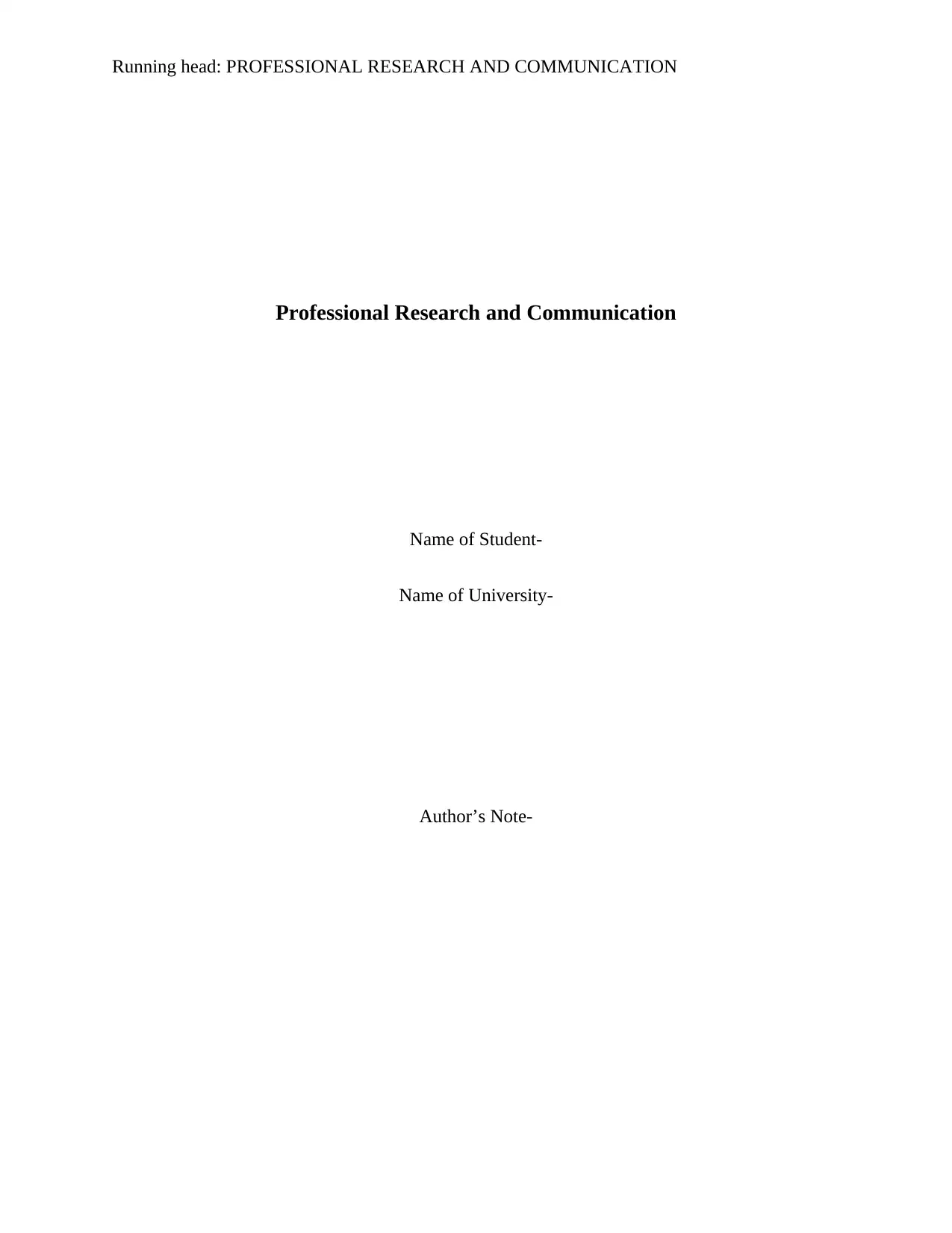
Running head: PROFESSIONAL RESEARCH AND COMMUNICATION
Professional Research and Communication
Name of Student-
Name of University-
Author’s Note-
Professional Research and Communication
Name of Student-
Name of University-
Author’s Note-
Paraphrase This Document
Need a fresh take? Get an instant paraphrase of this document with our AI Paraphraser
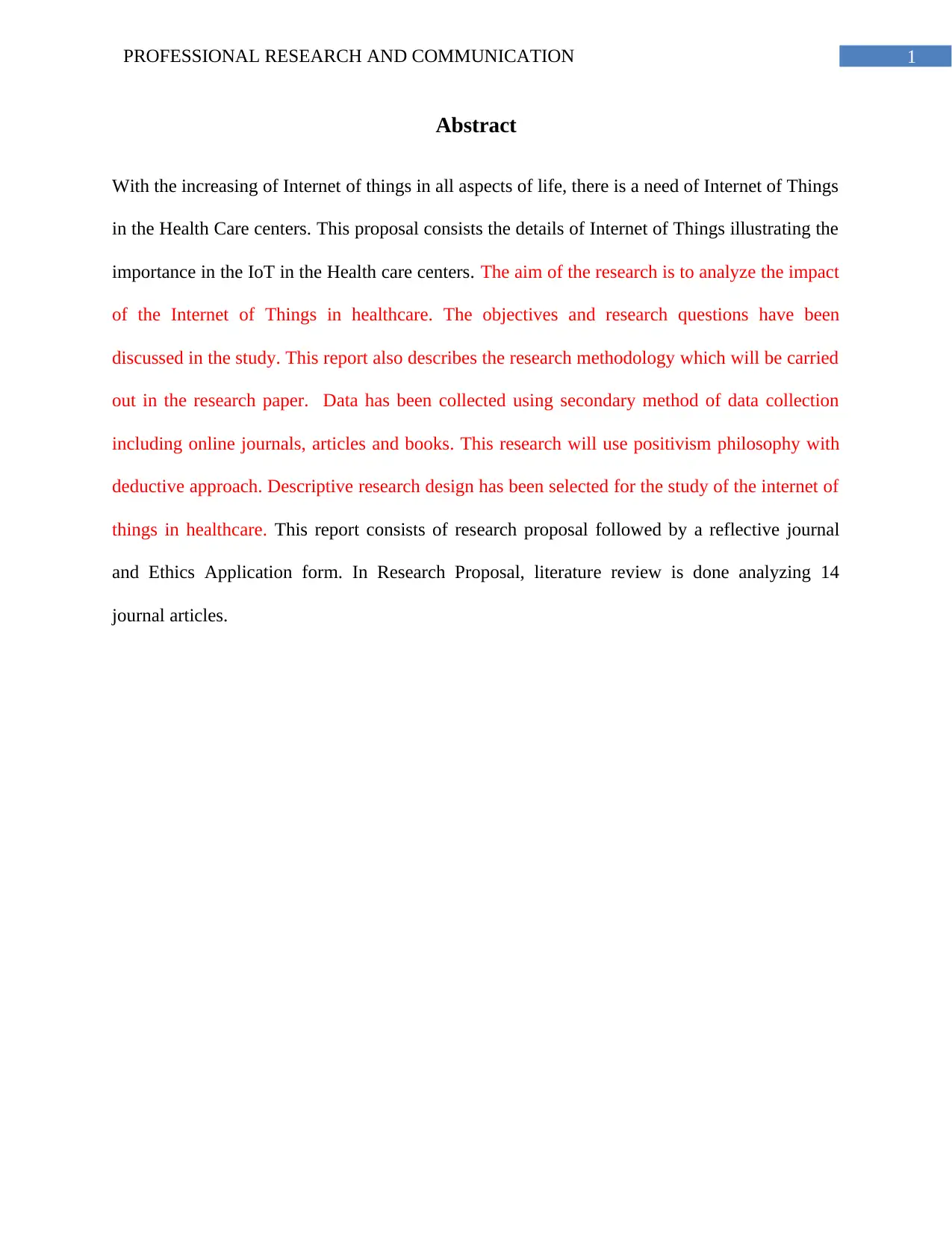
1PROFESSIONAL RESEARCH AND COMMUNICATION
Abstract
With the increasing of Internet of things in all aspects of life, there is a need of Internet of Things
in the Health Care centers. This proposal consists the details of Internet of Things illustrating the
importance in the IoT in the Health care centers. The aim of the research is to analyze the impact
of the Internet of Things in healthcare. The objectives and research questions have been
discussed in the study. This report also describes the research methodology which will be carried
out in the research paper. Data has been collected using secondary method of data collection
including online journals, articles and books. This research will use positivism philosophy with
deductive approach. Descriptive research design has been selected for the study of the internet of
things in healthcare. This report consists of research proposal followed by a reflective journal
and Ethics Application form. In Research Proposal, literature review is done analyzing 14
journal articles.
Abstract
With the increasing of Internet of things in all aspects of life, there is a need of Internet of Things
in the Health Care centers. This proposal consists the details of Internet of Things illustrating the
importance in the IoT in the Health care centers. The aim of the research is to analyze the impact
of the Internet of Things in healthcare. The objectives and research questions have been
discussed in the study. This report also describes the research methodology which will be carried
out in the research paper. Data has been collected using secondary method of data collection
including online journals, articles and books. This research will use positivism philosophy with
deductive approach. Descriptive research design has been selected for the study of the internet of
things in healthcare. This report consists of research proposal followed by a reflective journal
and Ethics Application form. In Research Proposal, literature review is done analyzing 14
journal articles.
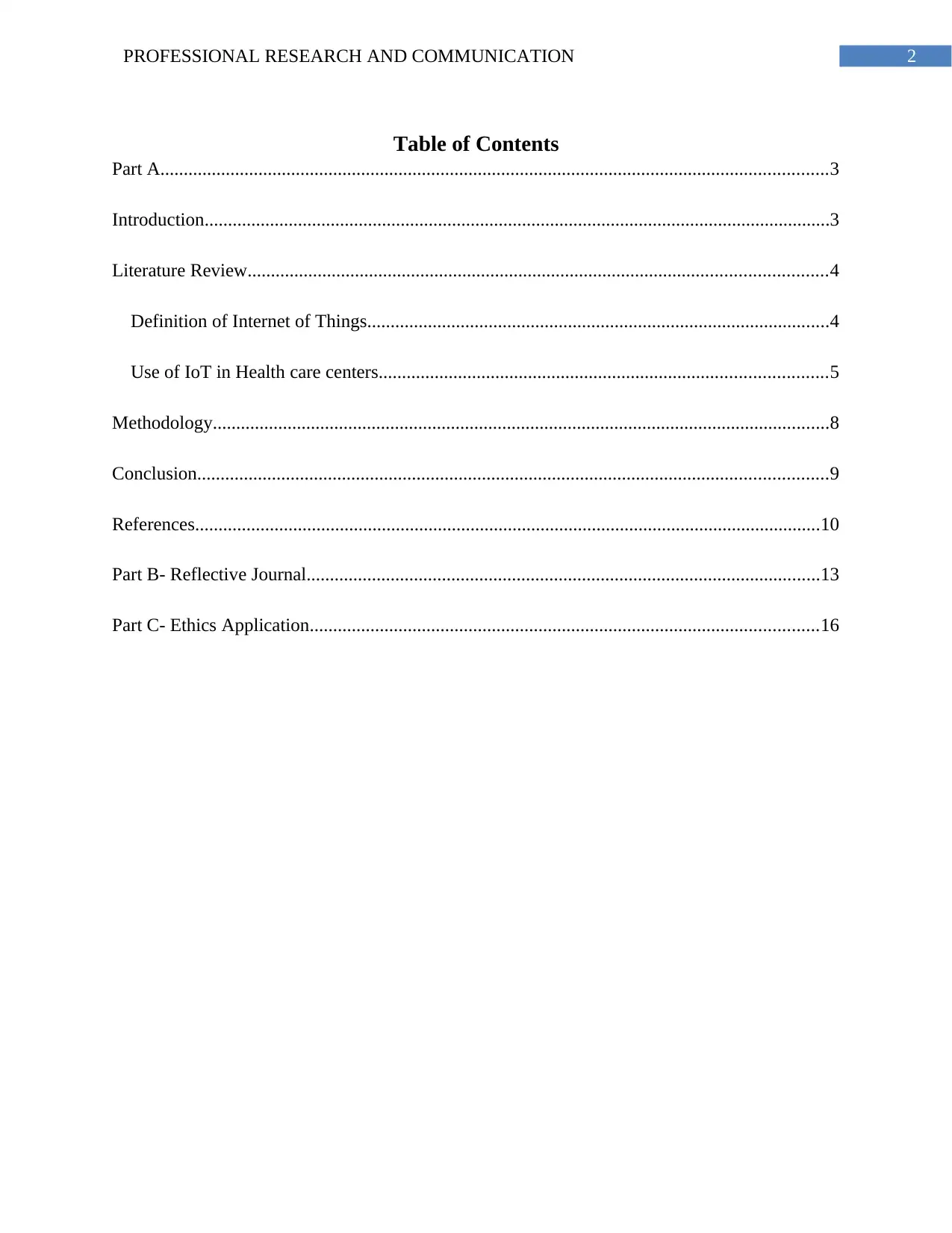
2PROFESSIONAL RESEARCH AND COMMUNICATION
Table of Contents
Part A...............................................................................................................................................3
Introduction......................................................................................................................................3
Literature Review............................................................................................................................4
Definition of Internet of Things...................................................................................................4
Use of IoT in Health care centers................................................................................................5
Methodology....................................................................................................................................8
Conclusion.......................................................................................................................................9
References......................................................................................................................................10
Part B- Reflective Journal..............................................................................................................13
Part C- Ethics Application.............................................................................................................16
Table of Contents
Part A...............................................................................................................................................3
Introduction......................................................................................................................................3
Literature Review............................................................................................................................4
Definition of Internet of Things...................................................................................................4
Use of IoT in Health care centers................................................................................................5
Methodology....................................................................................................................................8
Conclusion.......................................................................................................................................9
References......................................................................................................................................10
Part B- Reflective Journal..............................................................................................................13
Part C- Ethics Application.............................................................................................................16
⊘ This is a preview!⊘
Do you want full access?
Subscribe today to unlock all pages.

Trusted by 1+ million students worldwide
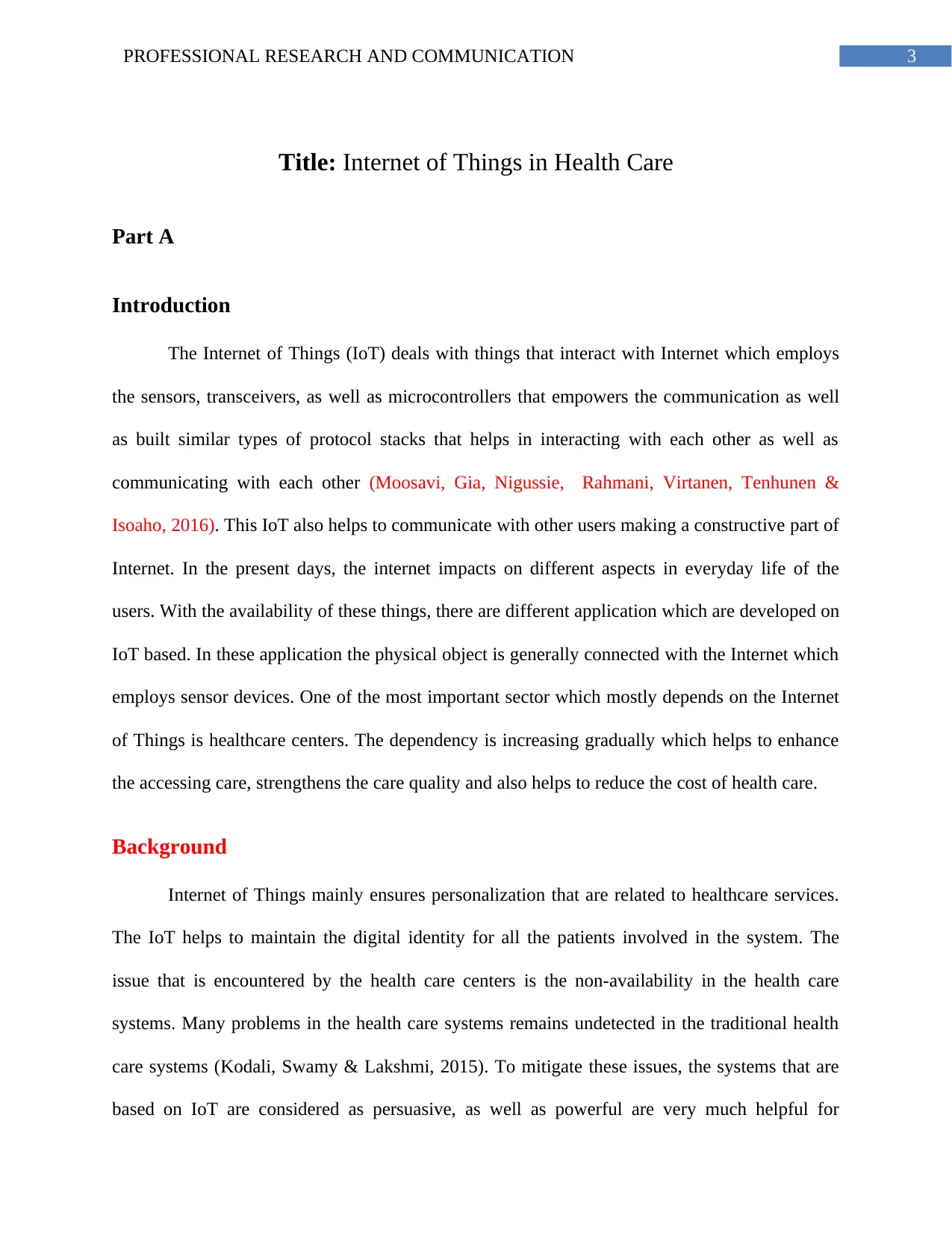
3PROFESSIONAL RESEARCH AND COMMUNICATION
Title: Internet of Things in Health Care
Part A
Introduction
The Internet of Things (IoT) deals with things that interact with Internet which employs
the sensors, transceivers, as well as microcontrollers that empowers the communication as well
as built similar types of protocol stacks that helps in interacting with each other as well as
communicating with each other (Moosavi, Gia, Nigussie, Rahmani, Virtanen, Tenhunen &
Isoaho, 2016). This IoT also helps to communicate with other users making a constructive part of
Internet. In the present days, the internet impacts on different aspects in everyday life of the
users. With the availability of these things, there are different application which are developed on
IoT based. In these application the physical object is generally connected with the Internet which
employs sensor devices. One of the most important sector which mostly depends on the Internet
of Things is healthcare centers. The dependency is increasing gradually which helps to enhance
the accessing care, strengthens the care quality and also helps to reduce the cost of health care.
Background
Internet of Things mainly ensures personalization that are related to healthcare services.
The IoT helps to maintain the digital identity for all the patients involved in the system. The
issue that is encountered by the health care centers is the non-availability in the health care
systems. Many problems in the health care systems remains undetected in the traditional health
care systems (Kodali, Swamy & Lakshmi, 2015). To mitigate these issues, the systems that are
based on IoT are considered as persuasive, as well as powerful are very much helpful for
Title: Internet of Things in Health Care
Part A
Introduction
The Internet of Things (IoT) deals with things that interact with Internet which employs
the sensors, transceivers, as well as microcontrollers that empowers the communication as well
as built similar types of protocol stacks that helps in interacting with each other as well as
communicating with each other (Moosavi, Gia, Nigussie, Rahmani, Virtanen, Tenhunen &
Isoaho, 2016). This IoT also helps to communicate with other users making a constructive part of
Internet. In the present days, the internet impacts on different aspects in everyday life of the
users. With the availability of these things, there are different application which are developed on
IoT based. In these application the physical object is generally connected with the Internet which
employs sensor devices. One of the most important sector which mostly depends on the Internet
of Things is healthcare centers. The dependency is increasing gradually which helps to enhance
the accessing care, strengthens the care quality and also helps to reduce the cost of health care.
Background
Internet of Things mainly ensures personalization that are related to healthcare services.
The IoT helps to maintain the digital identity for all the patients involved in the system. The
issue that is encountered by the health care centers is the non-availability in the health care
systems. Many problems in the health care systems remains undetected in the traditional health
care systems (Kodali, Swamy & Lakshmi, 2015). To mitigate these issues, the systems that are
based on IoT are considered as persuasive, as well as powerful are very much helpful for
Paraphrase This Document
Need a fresh take? Get an instant paraphrase of this document with our AI Paraphraser
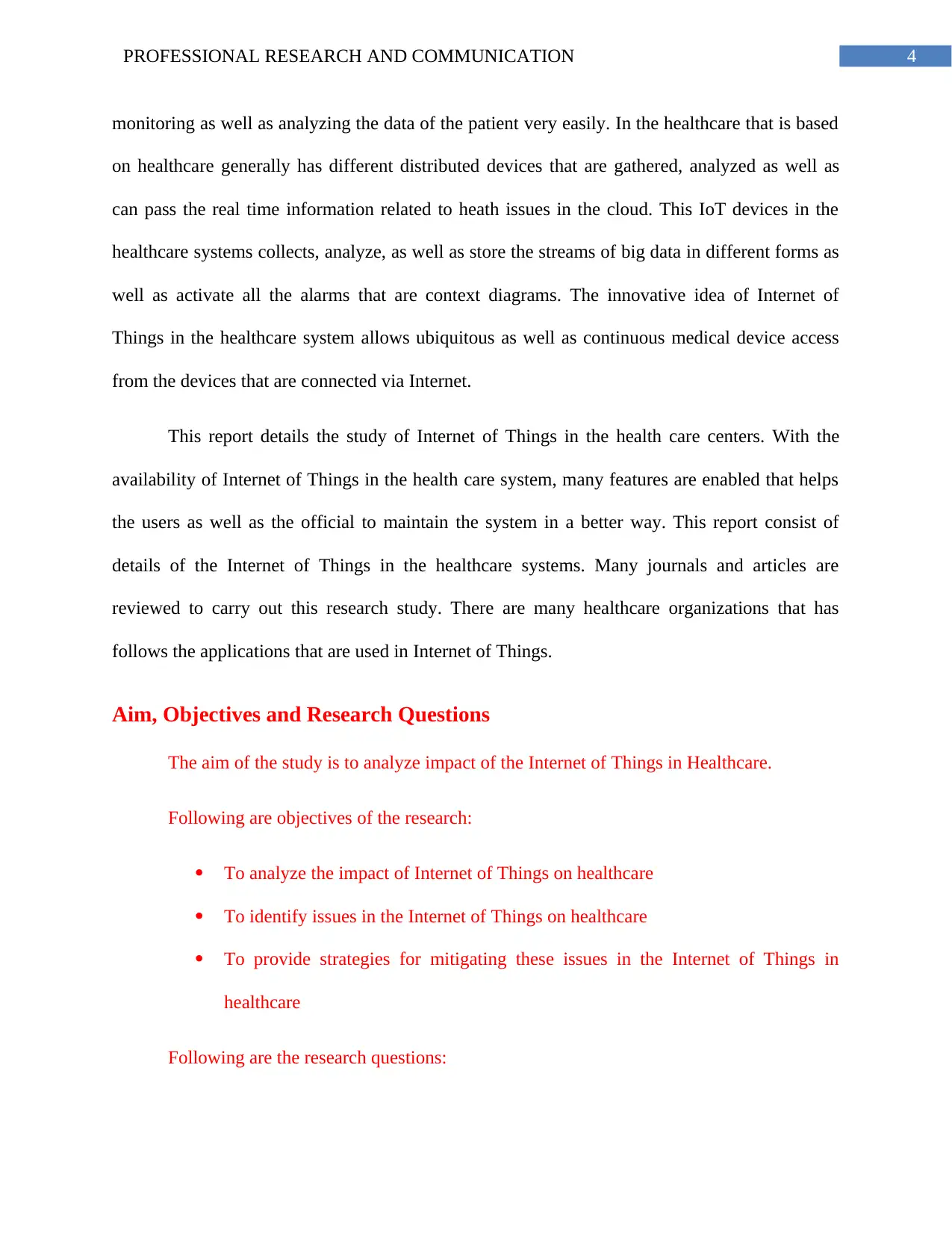
4PROFESSIONAL RESEARCH AND COMMUNICATION
monitoring as well as analyzing the data of the patient very easily. In the healthcare that is based
on healthcare generally has different distributed devices that are gathered, analyzed as well as
can pass the real time information related to heath issues in the cloud. This IoT devices in the
healthcare systems collects, analyze, as well as store the streams of big data in different forms as
well as activate all the alarms that are context diagrams. The innovative idea of Internet of
Things in the healthcare system allows ubiquitous as well as continuous medical device access
from the devices that are connected via Internet.
This report details the study of Internet of Things in the health care centers. With the
availability of Internet of Things in the health care system, many features are enabled that helps
the users as well as the official to maintain the system in a better way. This report consist of
details of the Internet of Things in the healthcare systems. Many journals and articles are
reviewed to carry out this research study. There are many healthcare organizations that has
follows the applications that are used in Internet of Things.
Aim, Objectives and Research Questions
The aim of the study is to analyze impact of the Internet of Things in Healthcare.
Following are objectives of the research:
To analyze the impact of Internet of Things on healthcare
To identify issues in the Internet of Things on healthcare
To provide strategies for mitigating these issues in the Internet of Things in
healthcare
Following are the research questions:
monitoring as well as analyzing the data of the patient very easily. In the healthcare that is based
on healthcare generally has different distributed devices that are gathered, analyzed as well as
can pass the real time information related to heath issues in the cloud. This IoT devices in the
healthcare systems collects, analyze, as well as store the streams of big data in different forms as
well as activate all the alarms that are context diagrams. The innovative idea of Internet of
Things in the healthcare system allows ubiquitous as well as continuous medical device access
from the devices that are connected via Internet.
This report details the study of Internet of Things in the health care centers. With the
availability of Internet of Things in the health care system, many features are enabled that helps
the users as well as the official to maintain the system in a better way. This report consist of
details of the Internet of Things in the healthcare systems. Many journals and articles are
reviewed to carry out this research study. There are many healthcare organizations that has
follows the applications that are used in Internet of Things.
Aim, Objectives and Research Questions
The aim of the study is to analyze impact of the Internet of Things in Healthcare.
Following are objectives of the research:
To analyze the impact of Internet of Things on healthcare
To identify issues in the Internet of Things on healthcare
To provide strategies for mitigating these issues in the Internet of Things in
healthcare
Following are the research questions:
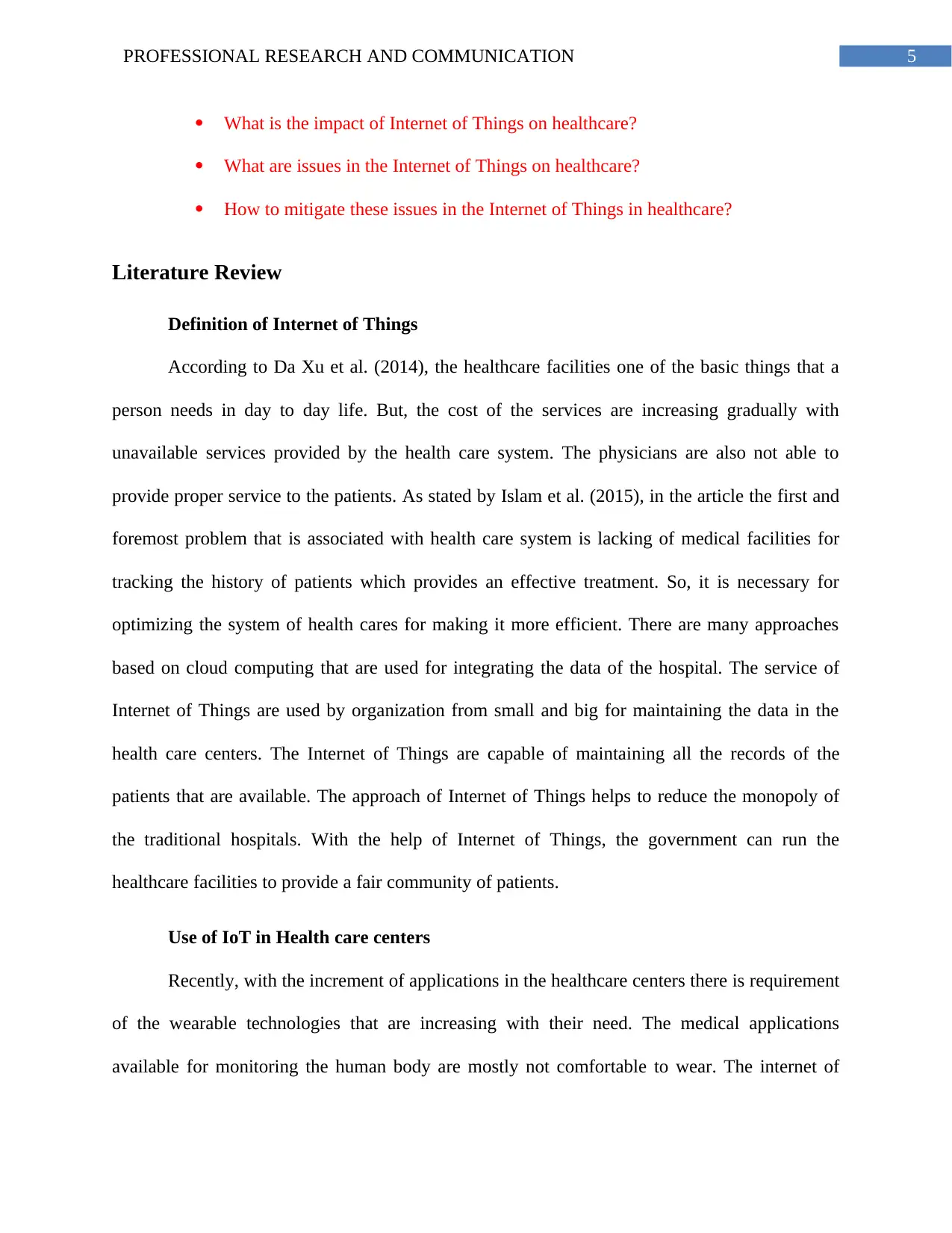
5PROFESSIONAL RESEARCH AND COMMUNICATION
What is the impact of Internet of Things on healthcare?
What are issues in the Internet of Things on healthcare?
How to mitigate these issues in the Internet of Things in healthcare?
Literature Review
Definition of Internet of Things
According to Da Xu et al. (2014), the healthcare facilities one of the basic things that a
person needs in day to day life. But, the cost of the services are increasing gradually with
unavailable services provided by the health care system. The physicians are also not able to
provide proper service to the patients. As stated by Islam et al. (2015), in the article the first and
foremost problem that is associated with health care system is lacking of medical facilities for
tracking the history of patients which provides an effective treatment. So, it is necessary for
optimizing the system of health cares for making it more efficient. There are many approaches
based on cloud computing that are used for integrating the data of the hospital. The service of
Internet of Things are used by organization from small and big for maintaining the data in the
health care centers. The Internet of Things are capable of maintaining all the records of the
patients that are available. The approach of Internet of Things helps to reduce the monopoly of
the traditional hospitals. With the help of Internet of Things, the government can run the
healthcare facilities to provide a fair community of patients.
Use of IoT in Health care centers
Recently, with the increment of applications in the healthcare centers there is requirement
of the wearable technologies that are increasing with their need. The medical applications
available for monitoring the human body are mostly not comfortable to wear. The internet of
What is the impact of Internet of Things on healthcare?
What are issues in the Internet of Things on healthcare?
How to mitigate these issues in the Internet of Things in healthcare?
Literature Review
Definition of Internet of Things
According to Da Xu et al. (2014), the healthcare facilities one of the basic things that a
person needs in day to day life. But, the cost of the services are increasing gradually with
unavailable services provided by the health care system. The physicians are also not able to
provide proper service to the patients. As stated by Islam et al. (2015), in the article the first and
foremost problem that is associated with health care system is lacking of medical facilities for
tracking the history of patients which provides an effective treatment. So, it is necessary for
optimizing the system of health cares for making it more efficient. There are many approaches
based on cloud computing that are used for integrating the data of the hospital. The service of
Internet of Things are used by organization from small and big for maintaining the data in the
health care centers. The Internet of Things are capable of maintaining all the records of the
patients that are available. The approach of Internet of Things helps to reduce the monopoly of
the traditional hospitals. With the help of Internet of Things, the government can run the
healthcare facilities to provide a fair community of patients.
Use of IoT in Health care centers
Recently, with the increment of applications in the healthcare centers there is requirement
of the wearable technologies that are increasing with their need. The medical applications
available for monitoring the human body are mostly not comfortable to wear. The internet of
⊘ This is a preview!⊘
Do you want full access?
Subscribe today to unlock all pages.

Trusted by 1+ million students worldwide
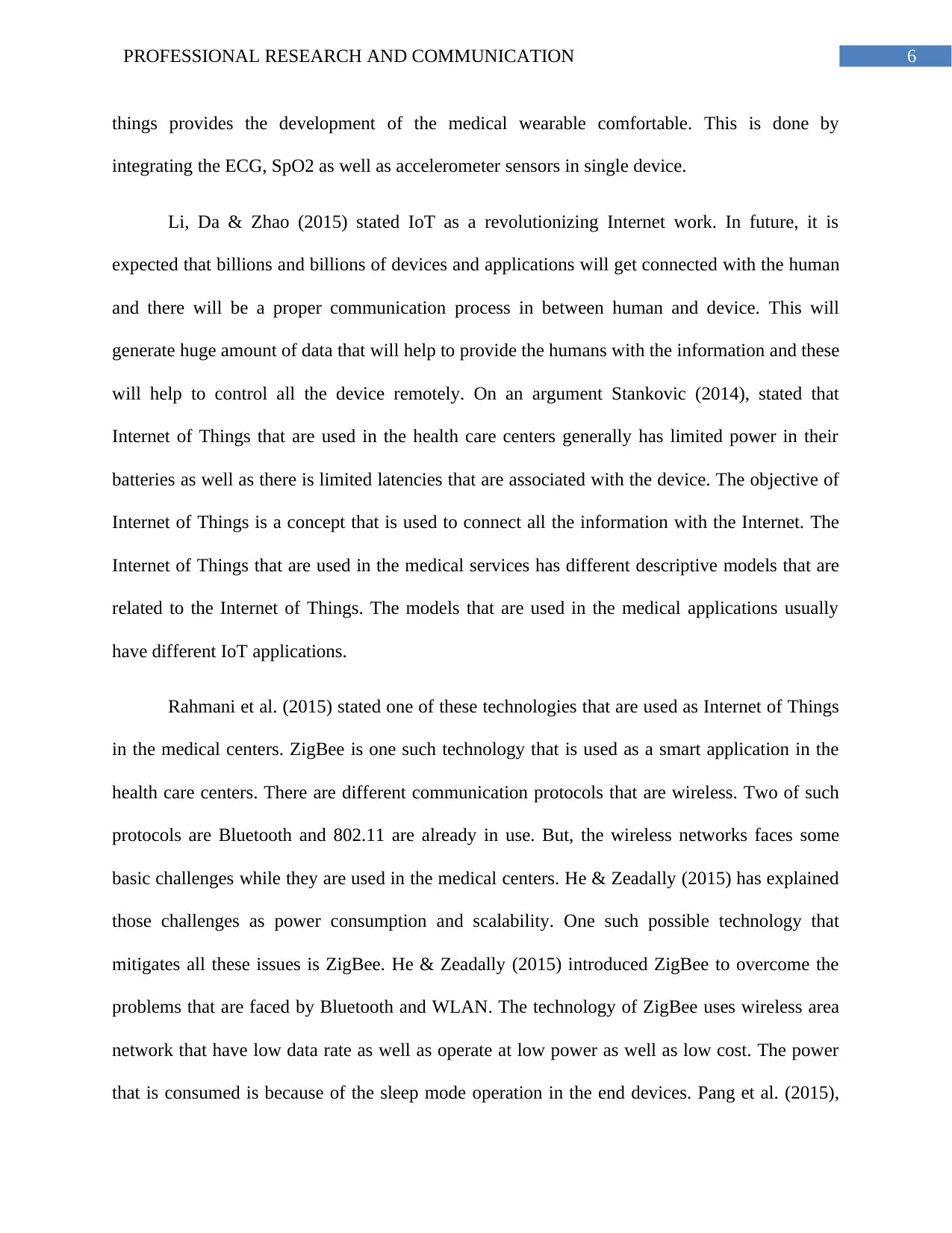
6PROFESSIONAL RESEARCH AND COMMUNICATION
things provides the development of the medical wearable comfortable. This is done by
integrating the ECG, SpO2 as well as accelerometer sensors in single device.
Li, Da & Zhao (2015) stated IoT as a revolutionizing Internet work. In future, it is
expected that billions and billions of devices and applications will get connected with the human
and there will be a proper communication process in between human and device. This will
generate huge amount of data that will help to provide the humans with the information and these
will help to control all the device remotely. On an argument Stankovic (2014), stated that
Internet of Things that are used in the health care centers generally has limited power in their
batteries as well as there is limited latencies that are associated with the device. The objective of
Internet of Things is a concept that is used to connect all the information with the Internet. The
Internet of Things that are used in the medical services has different descriptive models that are
related to the Internet of Things. The models that are used in the medical applications usually
have different IoT applications.
Rahmani et al. (2015) stated one of these technologies that are used as Internet of Things
in the medical centers. ZigBee is one such technology that is used as a smart application in the
health care centers. There are different communication protocols that are wireless. Two of such
protocols are Bluetooth and 802.11 are already in use. But, the wireless networks faces some
basic challenges while they are used in the medical centers. He & Zeadally (2015) has explained
those challenges as power consumption and scalability. One such possible technology that
mitigates all these issues is ZigBee. He & Zeadally (2015) introduced ZigBee to overcome the
problems that are faced by Bluetooth and WLAN. The technology of ZigBee uses wireless area
network that have low data rate as well as operate at low power as well as low cost. The power
that is consumed is because of the sleep mode operation in the end devices. Pang et al. (2015),
things provides the development of the medical wearable comfortable. This is done by
integrating the ECG, SpO2 as well as accelerometer sensors in single device.
Li, Da & Zhao (2015) stated IoT as a revolutionizing Internet work. In future, it is
expected that billions and billions of devices and applications will get connected with the human
and there will be a proper communication process in between human and device. This will
generate huge amount of data that will help to provide the humans with the information and these
will help to control all the device remotely. On an argument Stankovic (2014), stated that
Internet of Things that are used in the health care centers generally has limited power in their
batteries as well as there is limited latencies that are associated with the device. The objective of
Internet of Things is a concept that is used to connect all the information with the Internet. The
Internet of Things that are used in the medical services has different descriptive models that are
related to the Internet of Things. The models that are used in the medical applications usually
have different IoT applications.
Rahmani et al. (2015) stated one of these technologies that are used as Internet of Things
in the medical centers. ZigBee is one such technology that is used as a smart application in the
health care centers. There are different communication protocols that are wireless. Two of such
protocols are Bluetooth and 802.11 are already in use. But, the wireless networks faces some
basic challenges while they are used in the medical centers. He & Zeadally (2015) has explained
those challenges as power consumption and scalability. One such possible technology that
mitigates all these issues is ZigBee. He & Zeadally (2015) introduced ZigBee to overcome the
problems that are faced by Bluetooth and WLAN. The technology of ZigBee uses wireless area
network that have low data rate as well as operate at low power as well as low cost. The power
that is consumed is because of the sleep mode operation in the end devices. Pang et al. (2015),
Paraphrase This Document
Need a fresh take? Get an instant paraphrase of this document with our AI Paraphraser
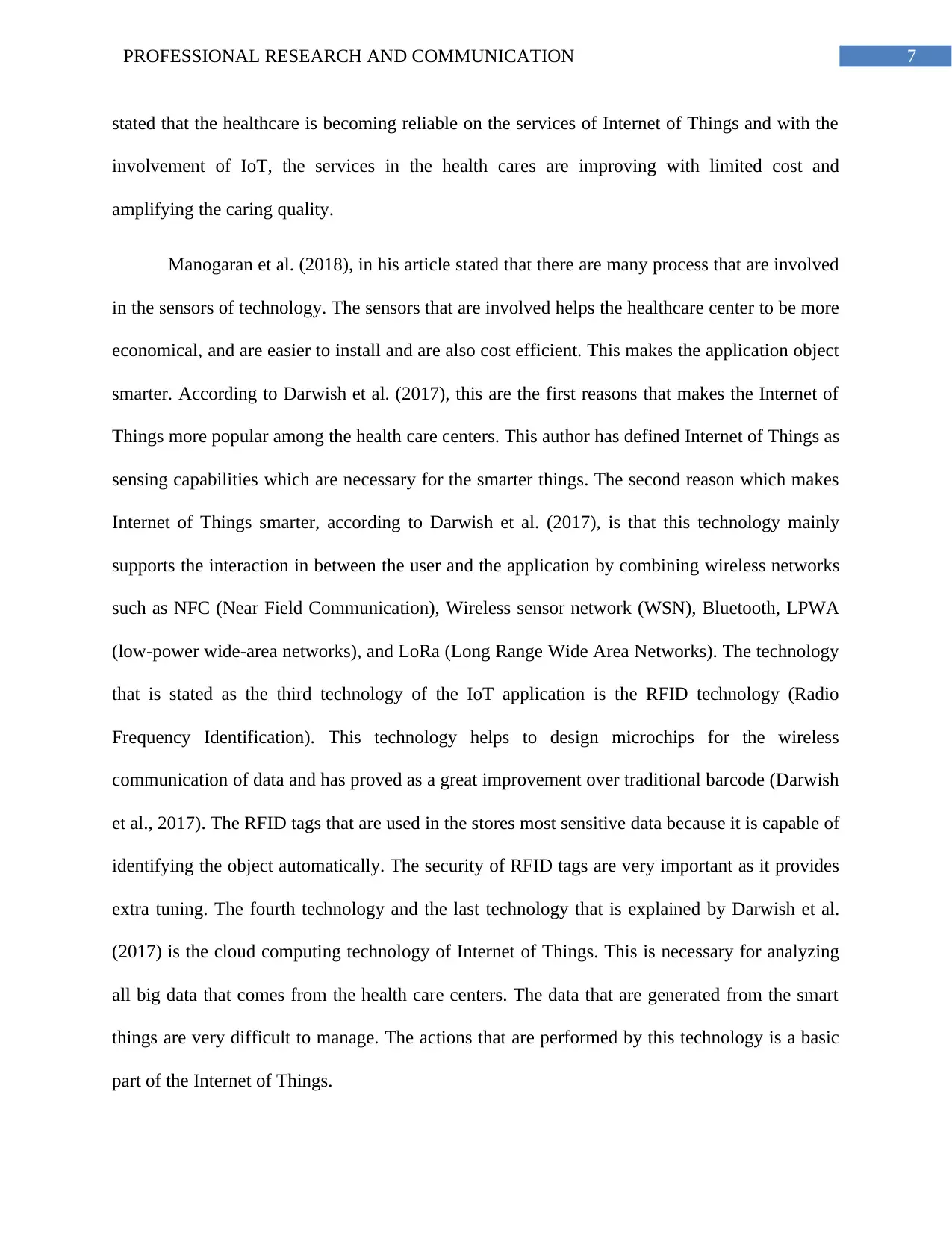
7PROFESSIONAL RESEARCH AND COMMUNICATION
stated that the healthcare is becoming reliable on the services of Internet of Things and with the
involvement of IoT, the services in the health cares are improving with limited cost and
amplifying the caring quality.
Manogaran et al. (2018), in his article stated that there are many process that are involved
in the sensors of technology. The sensors that are involved helps the healthcare center to be more
economical, and are easier to install and are also cost efficient. This makes the application object
smarter. According to Darwish et al. (2017), this are the first reasons that makes the Internet of
Things more popular among the health care centers. This author has defined Internet of Things as
sensing capabilities which are necessary for the smarter things. The second reason which makes
Internet of Things smarter, according to Darwish et al. (2017), is that this technology mainly
supports the interaction in between the user and the application by combining wireless networks
such as NFC (Near Field Communication), Wireless sensor network (WSN), Bluetooth, LPWA
(low-power wide-area networks), and LoRa (Long Range Wide Area Networks). The technology
that is stated as the third technology of the IoT application is the RFID technology (Radio
Frequency Identification). This technology helps to design microchips for the wireless
communication of data and has proved as a great improvement over traditional barcode (Darwish
et al., 2017). The RFID tags that are used in the stores most sensitive data because it is capable of
identifying the object automatically. The security of RFID tags are very important as it provides
extra tuning. The fourth technology and the last technology that is explained by Darwish et al.
(2017) is the cloud computing technology of Internet of Things. This is necessary for analyzing
all big data that comes from the health care centers. The data that are generated from the smart
things are very difficult to manage. The actions that are performed by this technology is a basic
part of the Internet of Things.
stated that the healthcare is becoming reliable on the services of Internet of Things and with the
involvement of IoT, the services in the health cares are improving with limited cost and
amplifying the caring quality.
Manogaran et al. (2018), in his article stated that there are many process that are involved
in the sensors of technology. The sensors that are involved helps the healthcare center to be more
economical, and are easier to install and are also cost efficient. This makes the application object
smarter. According to Darwish et al. (2017), this are the first reasons that makes the Internet of
Things more popular among the health care centers. This author has defined Internet of Things as
sensing capabilities which are necessary for the smarter things. The second reason which makes
Internet of Things smarter, according to Darwish et al. (2017), is that this technology mainly
supports the interaction in between the user and the application by combining wireless networks
such as NFC (Near Field Communication), Wireless sensor network (WSN), Bluetooth, LPWA
(low-power wide-area networks), and LoRa (Long Range Wide Area Networks). The technology
that is stated as the third technology of the IoT application is the RFID technology (Radio
Frequency Identification). This technology helps to design microchips for the wireless
communication of data and has proved as a great improvement over traditional barcode (Darwish
et al., 2017). The RFID tags that are used in the stores most sensitive data because it is capable of
identifying the object automatically. The security of RFID tags are very important as it provides
extra tuning. The fourth technology and the last technology that is explained by Darwish et al.
(2017) is the cloud computing technology of Internet of Things. This is necessary for analyzing
all big data that comes from the health care centers. The data that are generated from the smart
things are very difficult to manage. The actions that are performed by this technology is a basic
part of the Internet of Things.
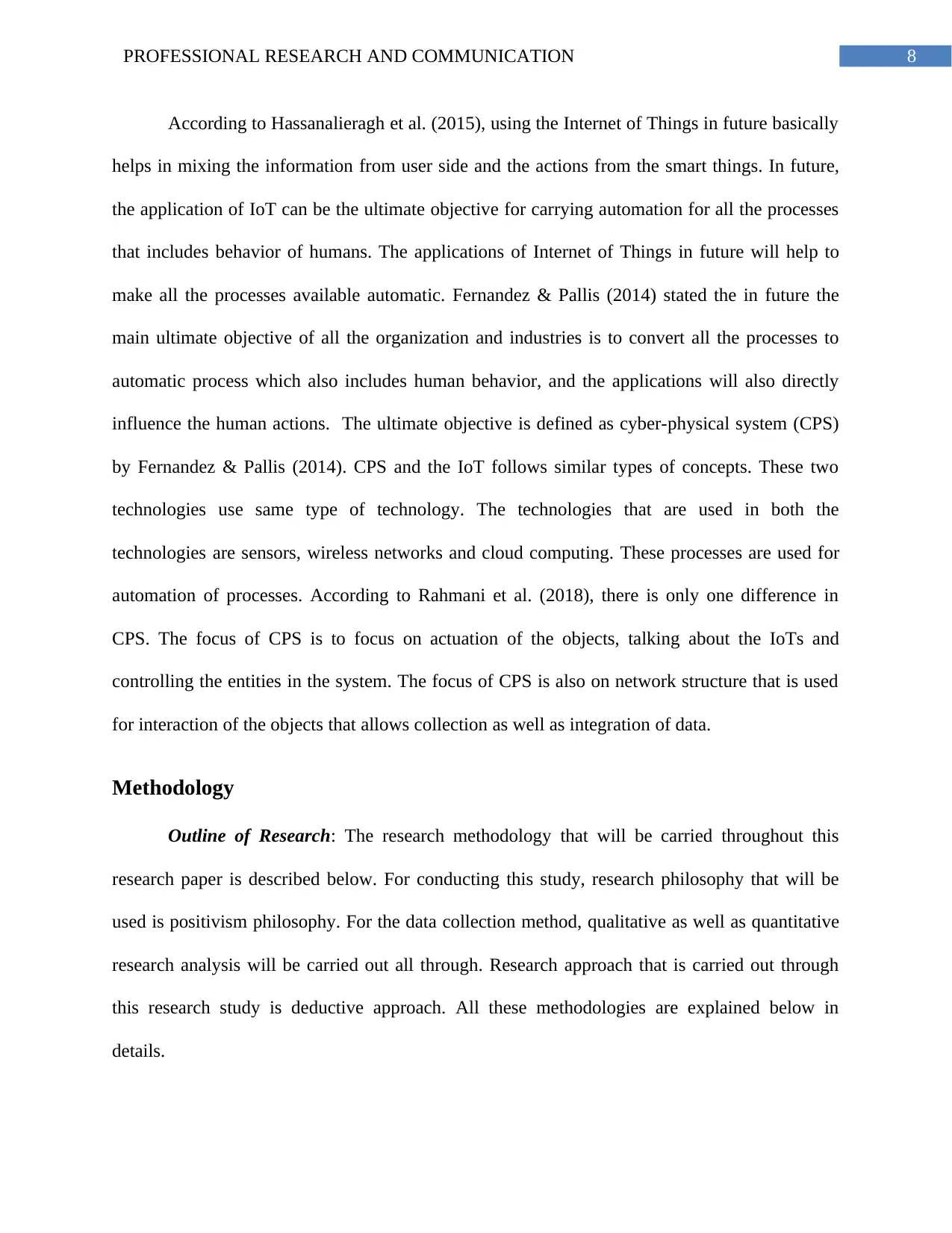
8PROFESSIONAL RESEARCH AND COMMUNICATION
According to Hassanalieragh et al. (2015), using the Internet of Things in future basically
helps in mixing the information from user side and the actions from the smart things. In future,
the application of IoT can be the ultimate objective for carrying automation for all the processes
that includes behavior of humans. The applications of Internet of Things in future will help to
make all the processes available automatic. Fernandez & Pallis (2014) stated the in future the
main ultimate objective of all the organization and industries is to convert all the processes to
automatic process which also includes human behavior, and the applications will also directly
influence the human actions. The ultimate objective is defined as cyber-physical system (CPS)
by Fernandez & Pallis (2014). CPS and the IoT follows similar types of concepts. These two
technologies use same type of technology. The technologies that are used in both the
technologies are sensors, wireless networks and cloud computing. These processes are used for
automation of processes. According to Rahmani et al. (2018), there is only one difference in
CPS. The focus of CPS is to focus on actuation of the objects, talking about the IoTs and
controlling the entities in the system. The focus of CPS is also on network structure that is used
for interaction of the objects that allows collection as well as integration of data.
Methodology
Outline of Research: The research methodology that will be carried throughout this
research paper is described below. For conducting this study, research philosophy that will be
used is positivism philosophy. For the data collection method, qualitative as well as quantitative
research analysis will be carried out all through. Research approach that is carried out through
this research study is deductive approach. All these methodologies are explained below in
details.
According to Hassanalieragh et al. (2015), using the Internet of Things in future basically
helps in mixing the information from user side and the actions from the smart things. In future,
the application of IoT can be the ultimate objective for carrying automation for all the processes
that includes behavior of humans. The applications of Internet of Things in future will help to
make all the processes available automatic. Fernandez & Pallis (2014) stated the in future the
main ultimate objective of all the organization and industries is to convert all the processes to
automatic process which also includes human behavior, and the applications will also directly
influence the human actions. The ultimate objective is defined as cyber-physical system (CPS)
by Fernandez & Pallis (2014). CPS and the IoT follows similar types of concepts. These two
technologies use same type of technology. The technologies that are used in both the
technologies are sensors, wireless networks and cloud computing. These processes are used for
automation of processes. According to Rahmani et al. (2018), there is only one difference in
CPS. The focus of CPS is to focus on actuation of the objects, talking about the IoTs and
controlling the entities in the system. The focus of CPS is also on network structure that is used
for interaction of the objects that allows collection as well as integration of data.
Methodology
Outline of Research: The research methodology that will be carried throughout this
research paper is described below. For conducting this study, research philosophy that will be
used is positivism philosophy. For the data collection method, qualitative as well as quantitative
research analysis will be carried out all through. Research approach that is carried out through
this research study is deductive approach. All these methodologies are explained below in
details.
⊘ This is a preview!⊘
Do you want full access?
Subscribe today to unlock all pages.

Trusted by 1+ million students worldwide
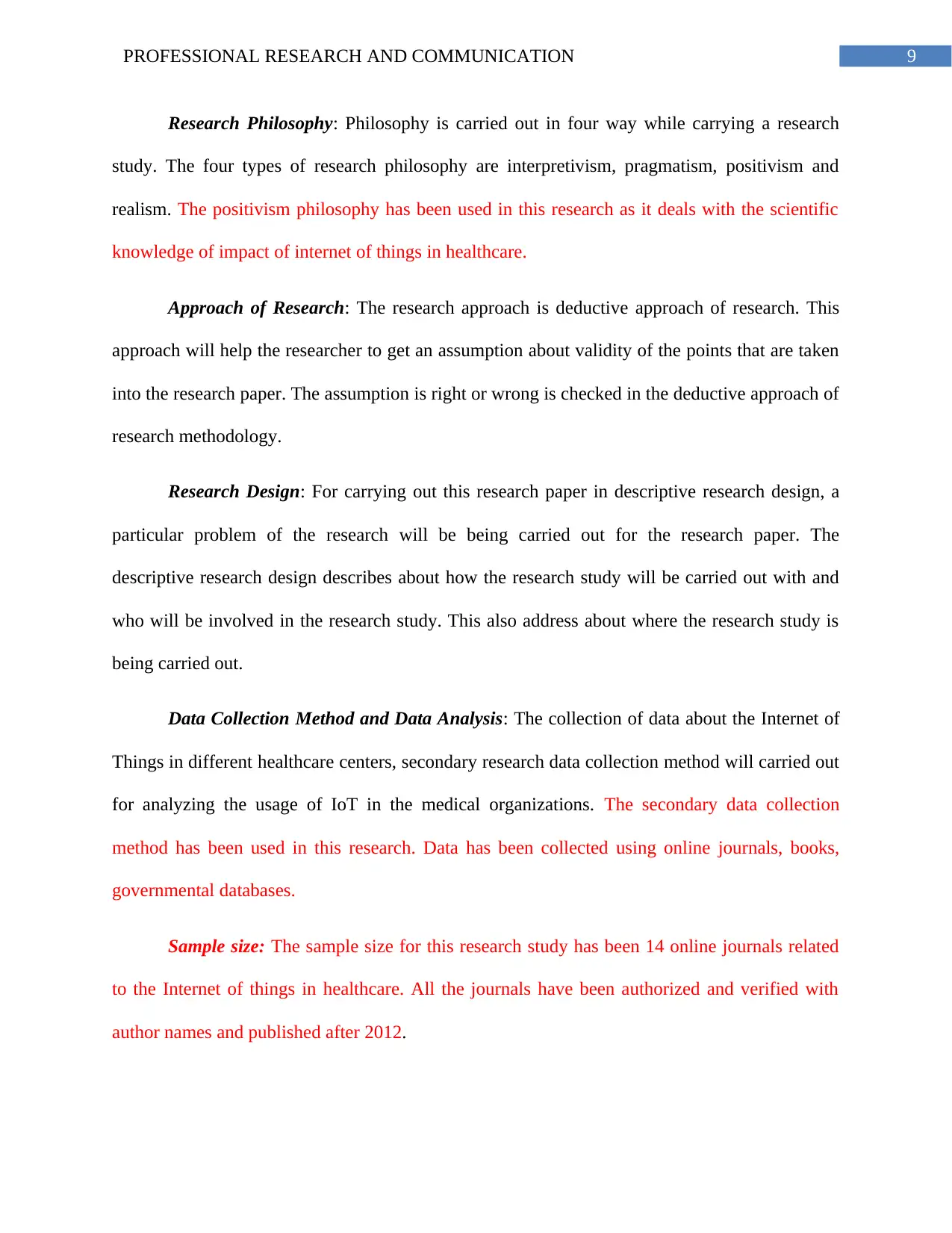
9PROFESSIONAL RESEARCH AND COMMUNICATION
Research Philosophy: Philosophy is carried out in four way while carrying a research
study. The four types of research philosophy are interpretivism, pragmatism, positivism and
realism. The positivism philosophy has been used in this research as it deals with the scientific
knowledge of impact of internet of things in healthcare.
Approach of Research: The research approach is deductive approach of research. This
approach will help the researcher to get an assumption about validity of the points that are taken
into the research paper. The assumption is right or wrong is checked in the deductive approach of
research methodology.
Research Design: For carrying out this research paper in descriptive research design, a
particular problem of the research will be being carried out for the research paper. The
descriptive research design describes about how the research study will be carried out with and
who will be involved in the research study. This also address about where the research study is
being carried out.
Data Collection Method and Data Analysis: The collection of data about the Internet of
Things in different healthcare centers, secondary research data collection method will carried out
for analyzing the usage of IoT in the medical organizations. The secondary data collection
method has been used in this research. Data has been collected using online journals, books,
governmental databases.
Sample size: The sample size for this research study has been 14 online journals related
to the Internet of things in healthcare. All the journals have been authorized and verified with
author names and published after 2012.
Research Philosophy: Philosophy is carried out in four way while carrying a research
study. The four types of research philosophy are interpretivism, pragmatism, positivism and
realism. The positivism philosophy has been used in this research as it deals with the scientific
knowledge of impact of internet of things in healthcare.
Approach of Research: The research approach is deductive approach of research. This
approach will help the researcher to get an assumption about validity of the points that are taken
into the research paper. The assumption is right or wrong is checked in the deductive approach of
research methodology.
Research Design: For carrying out this research paper in descriptive research design, a
particular problem of the research will be being carried out for the research paper. The
descriptive research design describes about how the research study will be carried out with and
who will be involved in the research study. This also address about where the research study is
being carried out.
Data Collection Method and Data Analysis: The collection of data about the Internet of
Things in different healthcare centers, secondary research data collection method will carried out
for analyzing the usage of IoT in the medical organizations. The secondary data collection
method has been used in this research. Data has been collected using online journals, books,
governmental databases.
Sample size: The sample size for this research study has been 14 online journals related
to the Internet of things in healthcare. All the journals have been authorized and verified with
author names and published after 2012.
Paraphrase This Document
Need a fresh take? Get an instant paraphrase of this document with our AI Paraphraser
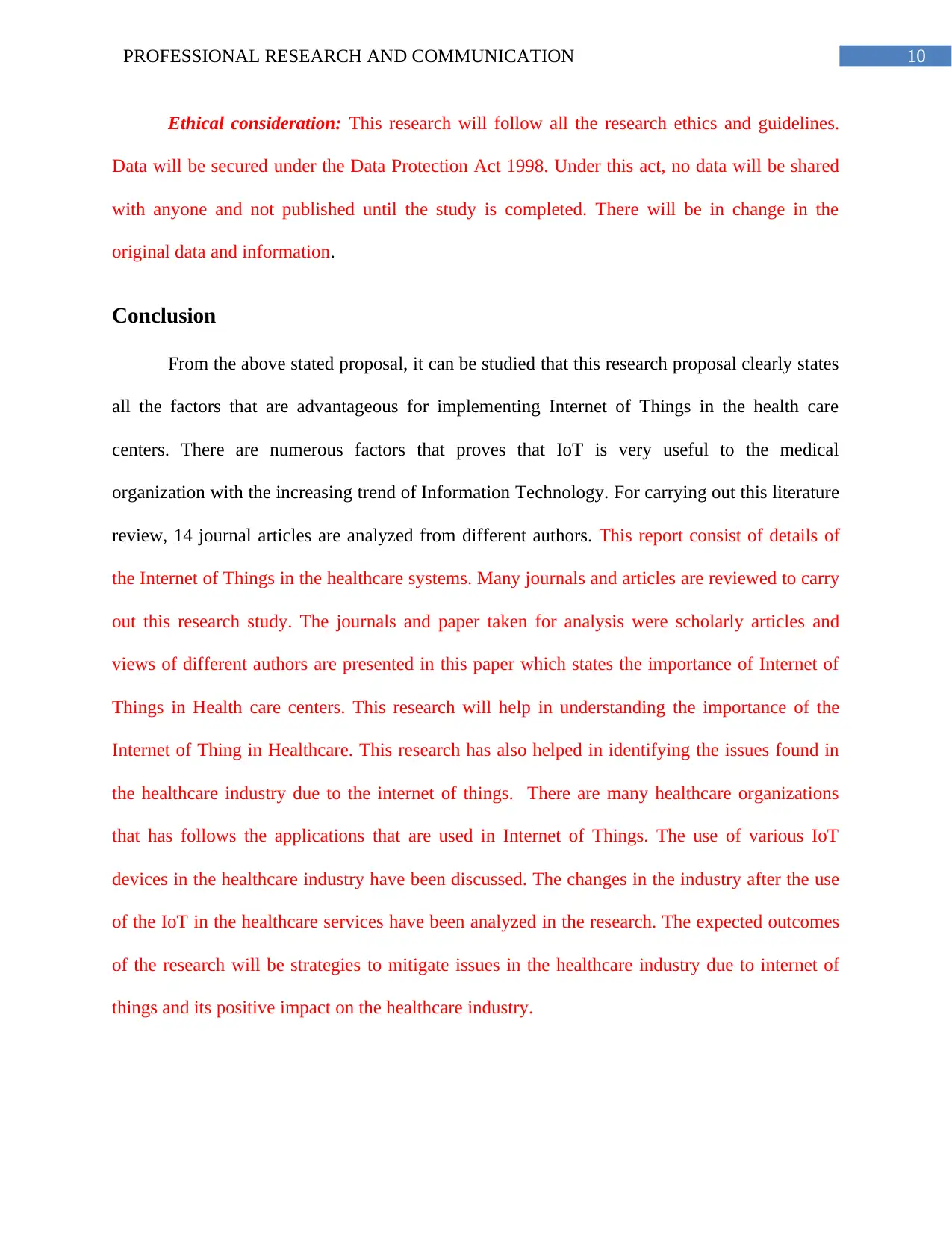
10PROFESSIONAL RESEARCH AND COMMUNICATION
Ethical consideration: This research will follow all the research ethics and guidelines.
Data will be secured under the Data Protection Act 1998. Under this act, no data will be shared
with anyone and not published until the study is completed. There will be in change in the
original data and information.
Conclusion
From the above stated proposal, it can be studied that this research proposal clearly states
all the factors that are advantageous for implementing Internet of Things in the health care
centers. There are numerous factors that proves that IoT is very useful to the medical
organization with the increasing trend of Information Technology. For carrying out this literature
review, 14 journal articles are analyzed from different authors. This report consist of details of
the Internet of Things in the healthcare systems. Many journals and articles are reviewed to carry
out this research study. The journals and paper taken for analysis were scholarly articles and
views of different authors are presented in this paper which states the importance of Internet of
Things in Health care centers. This research will help in understanding the importance of the
Internet of Thing in Healthcare. This research has also helped in identifying the issues found in
the healthcare industry due to the internet of things. There are many healthcare organizations
that has follows the applications that are used in Internet of Things. The use of various IoT
devices in the healthcare industry have been discussed. The changes in the industry after the use
of the IoT in the healthcare services have been analyzed in the research. The expected outcomes
of the research will be strategies to mitigate issues in the healthcare industry due to internet of
things and its positive impact on the healthcare industry.
Ethical consideration: This research will follow all the research ethics and guidelines.
Data will be secured under the Data Protection Act 1998. Under this act, no data will be shared
with anyone and not published until the study is completed. There will be in change in the
original data and information.
Conclusion
From the above stated proposal, it can be studied that this research proposal clearly states
all the factors that are advantageous for implementing Internet of Things in the health care
centers. There are numerous factors that proves that IoT is very useful to the medical
organization with the increasing trend of Information Technology. For carrying out this literature
review, 14 journal articles are analyzed from different authors. This report consist of details of
the Internet of Things in the healthcare systems. Many journals and articles are reviewed to carry
out this research study. The journals and paper taken for analysis were scholarly articles and
views of different authors are presented in this paper which states the importance of Internet of
Things in Health care centers. This research will help in understanding the importance of the
Internet of Thing in Healthcare. This research has also helped in identifying the issues found in
the healthcare industry due to the internet of things. There are many healthcare organizations
that has follows the applications that are used in Internet of Things. The use of various IoT
devices in the healthcare industry have been discussed. The changes in the industry after the use
of the IoT in the healthcare services have been analyzed in the research. The expected outcomes
of the research will be strategies to mitigate issues in the healthcare industry due to internet of
things and its positive impact on the healthcare industry.
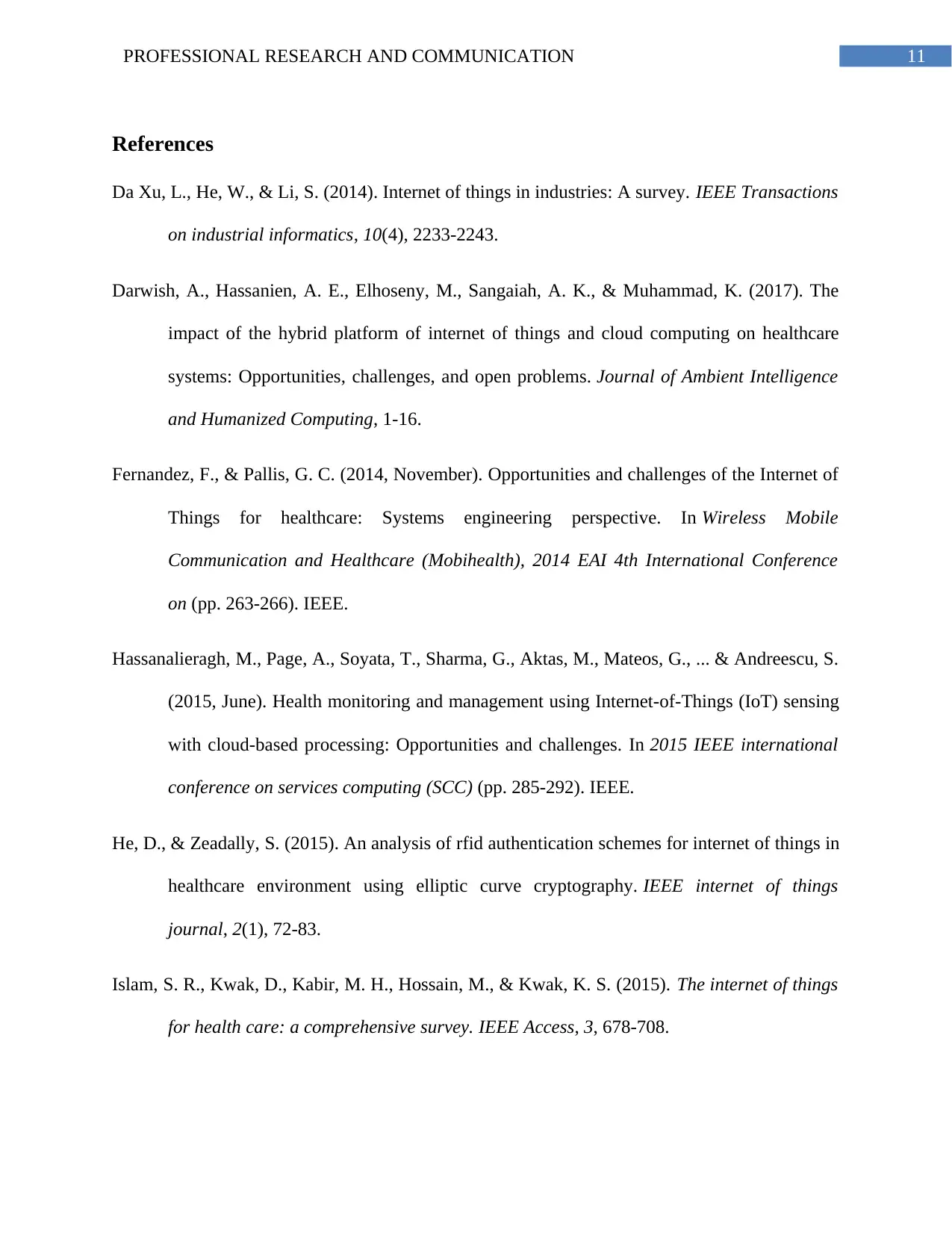
11PROFESSIONAL RESEARCH AND COMMUNICATION
References
Da Xu, L., He, W., & Li, S. (2014). Internet of things in industries: A survey. IEEE Transactions
on industrial informatics, 10(4), 2233-2243.
Darwish, A., Hassanien, A. E., Elhoseny, M., Sangaiah, A. K., & Muhammad, K. (2017). The
impact of the hybrid platform of internet of things and cloud computing on healthcare
systems: Opportunities, challenges, and open problems. Journal of Ambient Intelligence
and Humanized Computing, 1-16.
Fernandez, F., & Pallis, G. C. (2014, November). Opportunities and challenges of the Internet of
Things for healthcare: Systems engineering perspective. In Wireless Mobile
Communication and Healthcare (Mobihealth), 2014 EAI 4th International Conference
on (pp. 263-266). IEEE.
Hassanalieragh, M., Page, A., Soyata, T., Sharma, G., Aktas, M., Mateos, G., ... & Andreescu, S.
(2015, June). Health monitoring and management using Internet-of-Things (IoT) sensing
with cloud-based processing: Opportunities and challenges. In 2015 IEEE international
conference on services computing (SCC) (pp. 285-292). IEEE.
He, D., & Zeadally, S. (2015). An analysis of rfid authentication schemes for internet of things in
healthcare environment using elliptic curve cryptography. IEEE internet of things
journal, 2(1), 72-83.
Islam, S. R., Kwak, D., Kabir, M. H., Hossain, M., & Kwak, K. S. (2015). The internet of things
for health care: a comprehensive survey. IEEE Access, 3, 678-708.
References
Da Xu, L., He, W., & Li, S. (2014). Internet of things in industries: A survey. IEEE Transactions
on industrial informatics, 10(4), 2233-2243.
Darwish, A., Hassanien, A. E., Elhoseny, M., Sangaiah, A. K., & Muhammad, K. (2017). The
impact of the hybrid platform of internet of things and cloud computing on healthcare
systems: Opportunities, challenges, and open problems. Journal of Ambient Intelligence
and Humanized Computing, 1-16.
Fernandez, F., & Pallis, G. C. (2014, November). Opportunities and challenges of the Internet of
Things for healthcare: Systems engineering perspective. In Wireless Mobile
Communication and Healthcare (Mobihealth), 2014 EAI 4th International Conference
on (pp. 263-266). IEEE.
Hassanalieragh, M., Page, A., Soyata, T., Sharma, G., Aktas, M., Mateos, G., ... & Andreescu, S.
(2015, June). Health monitoring and management using Internet-of-Things (IoT) sensing
with cloud-based processing: Opportunities and challenges. In 2015 IEEE international
conference on services computing (SCC) (pp. 285-292). IEEE.
He, D., & Zeadally, S. (2015). An analysis of rfid authentication schemes for internet of things in
healthcare environment using elliptic curve cryptography. IEEE internet of things
journal, 2(1), 72-83.
Islam, S. R., Kwak, D., Kabir, M. H., Hossain, M., & Kwak, K. S. (2015). The internet of things
for health care: a comprehensive survey. IEEE Access, 3, 678-708.
⊘ This is a preview!⊘
Do you want full access?
Subscribe today to unlock all pages.

Trusted by 1+ million students worldwide
1 out of 19
Related Documents
Your All-in-One AI-Powered Toolkit for Academic Success.
+13062052269
info@desklib.com
Available 24*7 on WhatsApp / Email
![[object Object]](/_next/static/media/star-bottom.7253800d.svg)
Unlock your academic potential
Copyright © 2020–2025 A2Z Services. All Rights Reserved. Developed and managed by ZUCOL.



